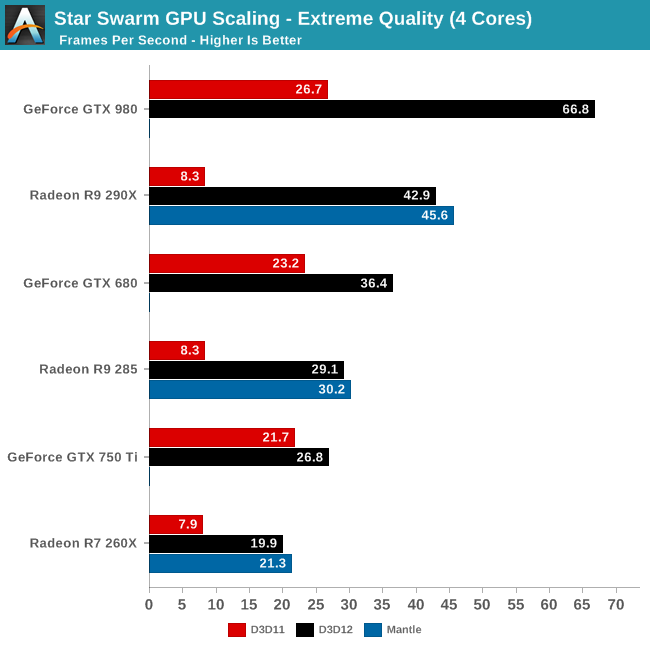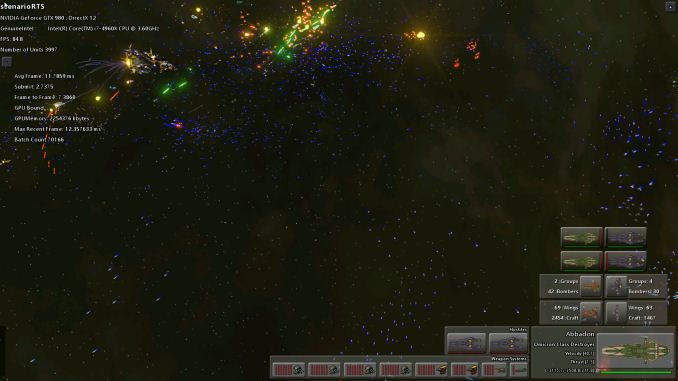The DirectX 12 Performance Preview: AMD, NVIDIA, & Star Swarm
by Ryan Smith on February 6, 2015 2:00 PM EST- Posted in
- GPUs
- AMD
- Microsoft
- NVIDIA
- DirectX 12
Star Swarm & The Test
For today’s DirectX 12 preview, Microsoft and Oxide Games have supplied us with a newer version of Oxide’s Star Swarm demo. Originally released in early 2014 as a demonstration of Oxide’s Nitrous engine and the capabilities of Mantle, Star Swarm is a massive space combat demo that is designed to push the limits of high-level APIs and demonstrate the performance advantages of low-level APIs. Due to its use of thousands of units and other effects that generate a high number of draw calls, Star Swarm can push over 100K draw calls, a massive workload that causes high-level APIs to simply crumple.
Because Star Swarm generates so many draw calls, it is essentially a best-case scenario test for low-level APIs, exploiting the fact that high-level APIs can’t effectively spread out the draw call workload over several CPU threads. As a result the performance gains from DirectX 12 in Star Swarm are going to be much greater than most (if not all) video games, but none the less it’s an effective tool to demonstrate the performance capabilities of DirectX 12 and to showcase how it is capable of better distributing work over multiple CPU threads.
It should be noted that while Star Swarm itself is a synthetic benchmark, the underlying Nitrous engine is relevant and is being used in multiple upcoming games. Stardock is using the Nitrous engine for their forthcoming Star Control game, and Oxide is using the engine for their own game, set to be announced at GDC 2015. So although Star Swarm is still a best case scenario, many of its lessons will be applicable to these future games.
As for the benchmark itself, we should also note that Star Swarm is a non-deterministic simulation. The benchmark is based on having two AI fleets fight each other, and as a result the outcome can differ from run to run. The good news is that although it’s not a deterministic benchmark, the benchmark’s RTS mode is reliable enough to keep the run-to-run variation low enough to produce reasonably consistent results. Among individual runs we’ll still see some fluctuations, while the benchmark will reliably demonstrate larger performance trends.
The Test
For today’s preview Microsoft, NVIDIA, and AMD have provided us with the necessary WDDM 2.0 drivers to enable DirectX 12 under Windows 10. The NVIDIA driver is 349.56 and the AMD driver is 15.200. At this time we do not know when these early WDDM 2.0 drivers will be released to the public, though we would be surprised not to see them released by the time of GDC in early March.
In terms of bugs and other known issues, Microsoft has informed us that there are some known memory and performance regressions in the current WDDM 2.0 path that have since been fixed in interim builds of Windows. In particular the WDDM 2.0 path may see slightly lower performance than the WDDM 1.3 path for older drivers, and there is an issue with memory exhaustion. For this reason Microsoft has suggested that a 3GB card is required to use the Star Swarm DirectX 12 binary, although in our tests we have been able to run it on 2GB cards seemingly without issue. Meanwhile DirectX 11 deferred context support is currently broken in the combination of Star Swarm and NVIDIA's drivers, causing Star Swarm to immediately crash, so these results are with D3D 11 deferred contexts disabled.
For today’s article we are looking at a small range of cards from both AMD and NVIDIA to showcase both performance and compatibility. For NVIDIA we are looking at the GTX 980 (Maxwell 2), GTX 750 Ti (Maxwell 1), and GTX 680 (Kepler). For AMD we are looking at the R9 290X (GCN 1.1), R9 285 (GCN 1.2), and R9 260X (GCN 1.1). As we mentioned earlier support for Fermi and GCN 1.0 cards will be forthcoming in future drivers.
Meanwhile on the CPU front, to showcase the performance scaling of Direct3D we are running the bulk of our tests on our GPU testbed with 3 different settings to roughly emulate high-end Core i7 (6 cores), i5 (4 cores), and i3 (2 cores) processors. Unfortunately we cannot control for our 4960X’s L3 cache size, however that should not be a significant factor in these benchmarks.
| DirectX 12 Preview CPU Configurations (i7-4960X) | |||
| Configuration | Emulating | ||
| 6C/12T @ 4.2GHz | Overclocked Core i7 | ||
| 4C/4T @ 3.8GHz | Core i5-4670K | ||
| 2C/4T @ 3.8GHz | Core i3-4370 | ||
Though not included in this preview, AMD’s recent APUs should slot between the 2 and 4 core options thanks to the design of AMD’s CPU modules.
| CPU: | Intel Core i7-4960X @ 4.2GHz |
| Motherboard: | ASRock Fatal1ty X79 Professional |
| Power Supply: | Corsair AX1200i |
| Hard Disk: | Samsung SSD 840 EVO (750GB) |
| Memory: | G.Skill RipjawZ DDR3-1866 4 x 8GB (9-10-9-26) |
| Case: | NZXT Phantom 630 Windowed Edition |
| Monitor: | Asus PQ321 |
| Video Cards: | AMD Radeon R9 290X AMD Radeon R9 285 AMD Radeon R7 260X NVIDIA GeForce GTX 980 NVIDIA GeForce GTX 750 Ti NVIDIA GeForce GTX 680 |
| Video Drivers: | NVIDIA Release 349.56 Beta AMD Catalyst 15.200 Beta |
| OS: | Windows 10 Technical Preview 2 (Build 9926) |
Finally, while we’re going to take a systematic look at DirectX 12 from both a CPU standpoint and a GPU standpoint, we may as well answer the first question on everyone’s mind: does DirectX 12 work as advertised? The short answer: a resounding yes.












245 Comments
View All Comments
loguerto - Saturday, February 7, 2015 - link
Microsoft is on the right way, but still, Mantle is the boss!FXi - Saturday, February 7, 2015 - link
I'm sadly more curious as to whether the 6 core chips prove their worth. A lot of rumor guessing seems to think that DX12 might finally show that a 6 core matters, but nothing here shows that. That's a very key issue when it comes to whether to go for a higher end chip or stick with the 4 core cpu's.GMAR - Saturday, February 7, 2015 - link
Excellent article. Thank you!Shahnewaz - Saturday, February 7, 2015 - link
Wait a minute, isn't the GTX 980 a 165W TDP card? Then how is it pulling over 200 watts?eRacer1 - Sunday, February 8, 2015 - link
The GTX 980 isn't pulling over 200W. The numbers shown are system power consumption not video card power consumption. The GTX 980 system power consumption isn't unusually high.Also, the system power consumption numbers are understating the power difference between the GTX 980 and Radeon 290X cards themselves under DX12. The GTX 980 has such a large performance advantage over the 290X in DX12 that the CPU is also using more power in the GTX 980 system to keep up with the video card.
If anything the 290X power consumption is "too low", especially under DX12. To me it looks like the GPU is being underutilized, which seems to be the case based on the low FPS results and power consumption numbers. That could be due to many reasons: poor driver optimization, 290X architectural limitations, benchmark bug or design choice, Windows 10 issue, 290X throttling problem, etc. Hopefully, for AMD's sake, those issues can be worked out before the Windows 10 launch.
Shahnewaz - Sunday, February 8, 2015 - link
That doesn't explain the <20W difference in both systems.And it's not like the CPU usage is also radically different.
Remember, the TDP difference between the GPUs is a massive 165W (290W vs 165W).
eRacer1 - Sunday, February 8, 2015 - link
"That doesn't explain the <20W difference in both systems. And it's not like the CPU usage is also radically different."Looking at the CPU usage graphs in the review the GTX 980 DX12 CPU average across all four cores is about 80% while the 290X average is only about 50%. So the GTX 980 CPU is doing 60% more work. That alone could easily account for 20+W watts of extra power consumption on CPU in the GTX 980 system. The ~60% CPU higher usage in the GTX 980 system makes sense as the frame rate is 56% higher as well. So what looks like a 14W difference is probably more like a 35W difference between the GTX 980 and 290X video cards.
But the 35W difference doesn't tell the whole story because the GTX 980 is also 56% faster while using less power. So the GTX 980 has a MASSIVE efficiency advantage under these benchmark conditions. And it is doing it within a reasonable TDP because by the time you back out all of the non-GPU power consumption (CPU, memory, motherboard, hard drive, fans, etc.) and PSU inefficiency losses from the 271W system power consumption you'd likely find that the GTX 980 is under 200W.
So the question we are left with is why is a 290W TDP 290X system power consumption only 285W under DX12? By the time you subtract the CPU power consumption (which is somewhat less than that of the GTX 980 test due to only being at 50% load instead of 80%), motherboard, memory and other components the 290X is probably using only 200-220W. To me it looks like the 290X is being bottlenecked and as a result isn't using as much power as one would expect. What the source of the bottleneck is, and if it is correctable, remains a mystery.
Shahnewaz - Saturday, February 7, 2015 - link
It looks like AMD GPUs will get some 400%+ performance improvements! Sick!ET - Sunday, February 8, 2015 - link
My main takeaway from the article is that NVIDIA has done a much better job of optimising its DX11 drivers. AMD needs low level badly.bloodypulp - Sunday, February 8, 2015 - link
They already have it: Mantle.